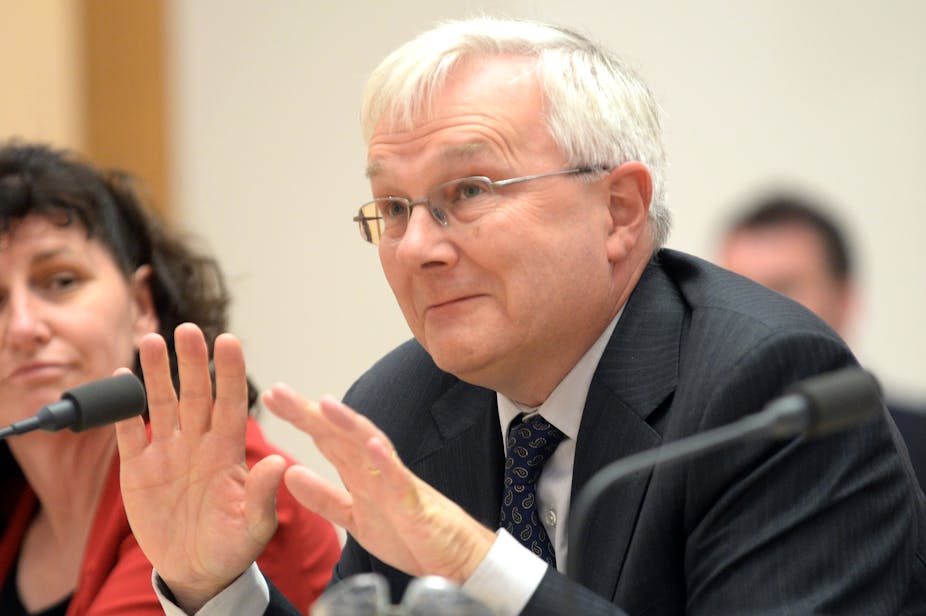The Abbott Government’s Commission of Audit should consider revenue raising measures as well as reviewing expenditure, a Senate inquiry has heard today.
The Commission has been tasked with “[making] recommendations to achieve savings sufficient to deliver a surplus”. But the Senate committee heard that Australia had a relatively small and efficient public expenditure, much the same size it was a decade ago.
Tim Lyons, assistant secretary of the ACTU, told the committee the Commission was was “premised on the in-principle view that private provision will always result in better outcomes”.
Others the committee heard from, including The Australia Insitute’s Richard Denniss and the University of Canberra’s Ian McAuley, suggested the premise that the government should “live within its means” was “emotional”, without any real meaning.
The Grattan Institute’s John Daley said political pressure to continue spending was high. He said the Commission should consider sharing the burden of cuts to make them easier to sell to the public.
But Labor senator Sue Lines questioned Daley on whether sharing the burden was possible. “We don’t live in an equal society so for for someone who sits on $19 an hour, who grosses round $600 a week, how do they share the burden equally [with high-income workers],” she said.
The Grattan Institute’s submission referred to expanding the GST in an effort to raise revenue, but Daley told the hearing that the clear aim was to take “far more from people who could afford it”. He said an expanded GST could fund increases in welfare to help low-income workers cope with the increase.
“Increasing income taxes may lead to less welfare churn, but it’s more distortionary,” Daley said. “Income taxes discourage people from working, but the GST discourages people from spending.”
“If you increase the GST to raise $15 billion, you can give away $1.5 billion to the 20% at the bottom who pay 10% of all GST, which means you get $13.5 million in front.”
“A $13.5 billion increase in income tax, which is what bracket creep will be if you don’t touch taxes for a decade, will have more of an impact on economic activity, especially the middle-income earner who would pay 4% more in tax,” he said.
Dr Richard Denniss, executive director of The Australia Institute, said Australia was a low tax country, particularly because large segments of the tax base had access to concessions. He pointed to an International Monetary Fund paper that found Australia had a high level of tax revenues foregone as a result of preferential treatment compared to other advanced economies.

But Ian McAuley, who is also a fellow at the Centre for Policy Development, said he wasn’t hopeful the Commission would consider raising revenue alongside cutting expenditure.
“Even though the Commission’s terms of reference do not explicitly rule out increasing revenue, [the Commissioners] did,” he said. “They said there would be a separate review into the tax system, so they have written it out.”
Professor Janine O'Flynn, a public management academic at the University of Melbourne, said failing to tackle the revenue side directly would be “a major flaw”.
She said it was unclear what was in and out of the scope of the Commission, and the terms of reference were open to interpretation. And she said the target to deliver a surplus of 1% of GDP was the core issue.
“In the first hearing we saw how difficult it was to get any clarity on whose estimates and modelling was being used. Whatever that figure is will be have a profound effect on recommendations,” she said.
The Labor and Greens-dominated committee also heard from the Business Council of Australia, whose president Tony Shepherd is chairing the Commission.
The committee’s Labor members, Senator Lines and Sam Dastyari, clashed with BCA deputy chief executive Maria Tarrant and acting chief economist Jarrod Ball over their position on corporate tax cuts, and whether public expenditure had grown.
Senator Dastyari accused Tarrant of running a “protection racket for the Commission” after she refused to say how long would be necessary for Australians to consider the Commission’s final report. The Commission won’t publicly release the report before the government uses it as a basis for the 2014 federal budget, a position the BCA is at odds with.
Phil Bowen, the Parliamentary Budget Officer, said that while he agreed that government expenditure as a proportion of GDP had remained relatively stable, government spending had grown 27% faster in real terms than the real GDP growth in the previous decade. Much of the difference, the committee heard, was because of better terms of trade during that time.

Bowen said that the structural deficit could persist until 2022 or 2023. He told the hearing that revenue and expenditure were “two sides of the budget coin” and government needed to have “regard to both sides”.
When asked by Senator Lines if the Commission’s findings wouldn’t be “the full picture” if the terms of reference excluded consideration of revenue, Bowen said “presumably the government will not simply be looking at expenditure but at the revenue side of the budget”.

